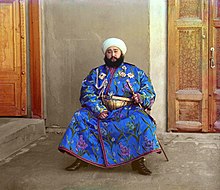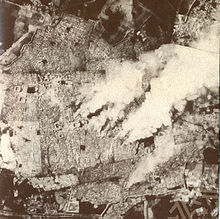Bukhara
![]()
Bukhara is a redirect to this article. For other meanings, see Bukhara (disambiguation).
![]()
This article or section needs revision: the name of the article would need final clarification in the discussion. It is also out of date as of 2008.
Please help improve
it, and then remove this tag.
Buxoro, German Buchara (pronunciation: [ˌbuxɒˈrɒ]; Tajik Бухоро Buchoro; Persian بُخارا Buchārā, DMG Boḫārā, New Persian pronunciation: [ˌboxɒ:rɒ:], besides Bochoro; Russian Бухара), is one of the most important cities of Uzbekistan and capital of the province of the same name.
The historical centre of Bukhara with its architectural monuments, including numerous mosques and medressas, has been listed as a UNESCO World Heritage Site since 1993.
The city is located on one of the ancient Silk Roads, had a population of about 235,500 in 2008 and is now one of the most important commercial and industrial centers in Central Asia. Most of the city's inhabitants are Tajiks and speak Tajik, the Central Asian form of Persian, as their mother tongue.
History
Early time
The oasis where Bukhara is located is situated in the historical landscape of Sogdia, which was initially part of the Persian Achaemenid Empire. From when the settlement of Bukhara developed and when the city was founded is unknown. The oldest pottery found in the city area dates back to the Hellenistic period, when the region was part of the Greco-Bactrian kingdom that emerged after the campaigns of Alexander the Great. Since some older settlements in the oasis have been archaeologically proven, an earlier settlement activity in the present urban area cannot be excluded. It is estimated that it was founded in the 6th century B.C. The importance of the city in pre-Islamic times is reflected in the coins minted by its rulers. Bukhara was one of the prosperous Sogdian city-states in late antiquity, when the region was borderland with the Neo-Persian Sassanid Empire, and was primarily interested in long-distance trade. In the two or more centuries before the establishment of Islamic rule over the region, Sogdia-and thus Bukhara-was at the height of economic and cultural wealth.
From the arrival of the Arabs
In 673/674, a series of raids by Muslim Arabs against Bukhara, which was supported by troops of Turkish peoples, began with the attack of Ubaidallah ibn Ziyad as part of the Arab campaigns of conquest. Although victorious in each case, the Arabs were initially unable to secure lasting rule over Transoxania. This changed only under Qutaiba ibn Muslim, who between 706 and 709 attempted, with difficulty, to Islamize the inhabitants of Bukhara and was installed as ruler of Bukhara in 710. In early Islamic times, the rulers of Bukhara were known as Bukhār Chudāt (or Bukhār Chudāh).
The Umayyads, however, had difficulty asserting themselves in Central Asia. Abu Muslim was partly responsible for the Abbasid victory, but his rule was not accepted in Bukhara, where there was a first revolt in 750, which was bloodily put down. Further revolts with different alliances and aims followed, for example between 776 and 779 under Al-Mukanna. This period of unrest only came to an end when the Persian Samanids came to power in 865 and Bukhara became the capital of a powerful empire, a thriving centre of trade and crafts as well as an intellectual pole of Islam in the East.
After the end of Samanid rule due to the invasion of Turkish peoples, the town lost political importance under the suzerainty of the Turkish Karakhanids from 999 onwards, but two important monuments bear witness to the cultural blossoming of the town under the Western Karakhanids: the Kalon minaret (Minār-i Qalyān, dated by an inscription to 1127) and the south facade of the Mag'oki Attori mosque (Masǧid-i maġāk-i ʿaṭṭārī), renewed at this time. The long reign of Arslan Khan (1102-1130) in particular was marked by relative prosperity and stability. However, from the late 11th century the western Karakhanids had to recognize the suzerainty of the Great Seljuks, which was followed in 1141 by that of the non-Muslim Kara Khitai. Bukhara during this period of changing overlords (12th to early 13th century) was mostly ruled by the local dynasty of the Burhanids, which was a set of spiritual leaders (Hanafites) with the title of Sadr. Having already been attacked by the Khorezm Shah Atsiz in 1139/40, the city was conquered in 1182 (and perhaps again in 1198) by his grandson Ala ad-Din Tekish, and finally came under the rule of Tekish's son Muhammad II in 1207.
From the Mongol rule
In 1220, Bukhara was conquered and largely destroyed by Genghis Khan's forces. Under his successor Ögedei Khan, the rebuilt city, repopulated by the inhabitants who had fled, was able to recover economically, although there is little evidence of Mongol building activity. Sustained development was hindered by, among other things, internal Mongol conflicts and those between factions of the population, and in 1238 there was the Tarabi uprising of the city's poor population. In 1263 the Mongol Khan Hülegü conquered the city and had several thousand people killed. In 1273 Mongol troops from Iran under Abaqa Khan followed - again many inhabitants were killed and enslaved. In 1276 troops of Ilkhan and Chagatai Khan raided the rural areas of Bukhara Oasis. In all, there was much severe destruction in the 1270s, with reportedly tens of thousands of deaths. Under Qaidu Khan and the administrator Masud Beg, the city was able to recover by the end of the 13th century.
During the Mongol period Bukhara reached its nadir and under the Timurids in the 14th century the city was only a provincial centre in the shadow of Samarqand. In 1316 the city was completely devastated, and in the 1330s Ibn Battuta described it as "...sparsely populated and ruinous". By the end of the 15th century Bukhara had lost its leading role in politics, military and trade; in science and mysticism it managed to retain it.
From the succession struggles at the end of the Timurid period a new power arose in Central Asia with the Uzbek Khanate, under which Bukhara experienced a new flowering in the 16th and 17th centuries. The first Uzbek dynasty was the Sheibanids (1500-1599), whose capital became Bukhara in 1533 under Ubaidullah. In 1540 the Miri Arab madrasa was opened. The city grew, became the most important in all of Central Asia, and under Abdullah II (Abdullah Khan) received numerous monuments that still define the cityscape today. The subsequent Janids also left their mark on the city with lively building activity. In 1598, the Kazakh Khan Tawakkul advanced as far as Bukhara. In 1647, when the orthodox clergy tried to depose the secular-minded Khan Nadir Mohammed, the Indian Mughals hoped to use this dispute over the throne to reclaim their old ancestral seats. An army of Shah Jahan conquered Bukhara in 1647 without encountering much opposition. The stubborn resistance of the Uzbeks, however, weakened the army so much that the later Shah Aurangzeb ordered the retreat of his troops from Bukhara to India.
The political and military strength of the rulers of Bukhara declined after the heyday from the middle of the 17th century and the population decreased. From 1710 the Keneges and Kitai-Kipchaks allied and proclaimed a counter-Khan in Samarkand. In the following years, and especially around 1723, large groups of Kazakhs fled from the Jungars to Bukhara and Samarkand. They allied with various Uzbek factions and besieged Bukhara several times until 1729. Bukhara was badly devastated by 1730.
In 1740, the Persians under Nader Shah turned on Bukhara after the raid against Delhi. The Janids surrendered after the Bukharian army was defeated due to superior Persian artillery. The Shah moved into Bukhara, which he regarded as an insignificant provincial city whose plunder and destruction he therefore refrained from. The ruler Abu'l Faiz became a vassal of Persia. The decline of Bukhara ended under the Manghit dynasty from 1747.
The city was once a main slave market. Slave trade still took place after the middle of the 19th century.
From the rule of the Russians
The Emirate of Bukhara lost its independence after the Russian conquest of large parts of Central Asia. Although Bukhara and its environs, unlike the eastern parts of the emirate (including Samarqand), were not annexed by Russia and incorporated into the new Turkestan General Government, the Russian-Bukharian Trade Treaty of 1868 sealed Russia's de facto control over Bukhara, especially over its foreign relations and economy. The emirate continued to exist within the Russian Empire until 1920.
On September 2, 1920, the Red Army occupied Bukhara during the Russian Civil War. Heavy fighting is said to have destroyed 75% of the city. On September 14, 1920, the Soviet People's Republic of Bukhara (BNSR, from September 19, 1924 Soviet Socialist Republic of Bukhara, BSSR) was proclaimed, closely tied to the Soviet Union through a series of treaties with the Russian SFSR. In November 1924 Bukhara was incorporated into the newly formed Uzbek Soviet Socialist Republic and thus into the Soviet Union. The Miri-Arab Madrasa, which reopened in 1945 with 60 places for students, was the only Islamic educational institution in the Soviet Union, with the exception of the short-lived Baraq Khan Madrasa in Tashkent, which existed from 1956 to 1961. It was therefore also attended by Muslims from the Volga region who wished to pursue an Islamic religious education. On 1 September 1991 Uzbekistan became an independent state.

The mausoleum of the Samanids from the 10th century is the oldest preserved building in the city

View of a typical courtyard

Citadel (Ark)

Last Emir of Bukhara Alim Khan (1911)

Fire in Bukhara after the attacks of the Red Army (1920)
Demographics
- 1900 :about 75.000, among them many Jews and Hindus
- 1911: 070.000
- 1920: 050.000
- 2008: 235.517
People of the Jewish faith had settled here since Roman times. Since the 16th century, they were known as Bukharian Jews. The Jewish cemetery of Bukhara counts 10,000 graves, but only 150 members of the community still lived in the city in 2018, few of whom observed the rites.
Questions and Answers
Q: What is Bukhara?
A: Bukhara is the capital city of the Bukhara Province located in Uzbekistan.
Q: How many people lived in Bukhara according to the 2009 census?
A: According to the 2009 census, about 263,400 people lived in Bukhara.
Q: What is the history of Bukhara?
A: People have lived in the area for at least five millennia, and the city has existed for half that time. Bukhara was located on the Silk Road, which made it a center of trade, scholarship, culture, and religion.
Q: What is listed as a World Heritage Site in Bukhara?
A: The historic center of Bukhara, which has many mosques and madrassas, is listed by UNESCO as a World Heritage Site.
Q: What is the significance of Bukhara's location on the Silk Road?
A: Bukhara's location on the Silk Road made it a center of trade, scholarship, culture, and religion.
Q: Who lives in Bukhara?
A: Many Uzbeks and Tajiks live in Bukhara. Additionally, the city has Jews and other ethnic minorities.
Q: What is Bukhara Province?
A: Bukhara Province is a province located in Uzbekistan, and Bukhara is its capital city.
Search within the encyclopedia